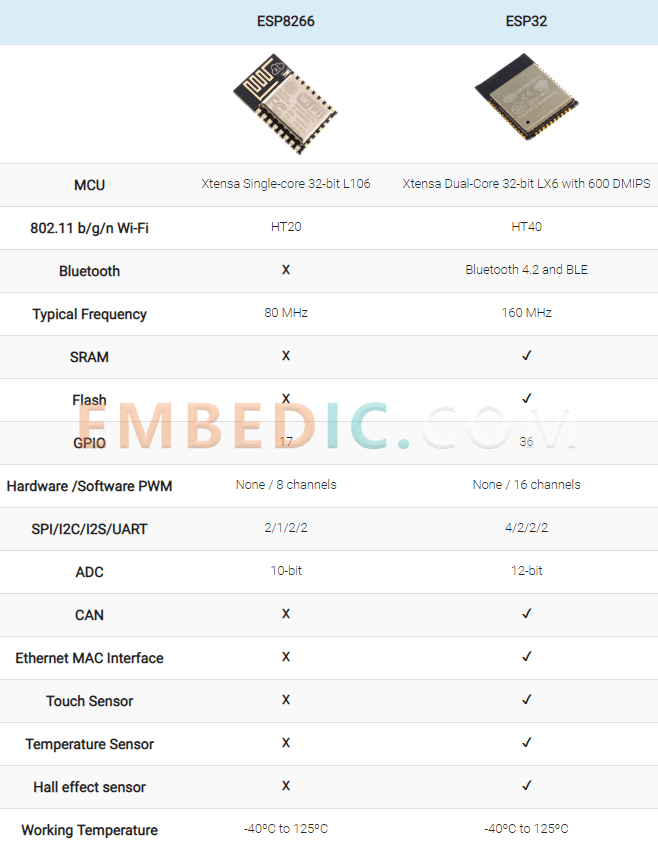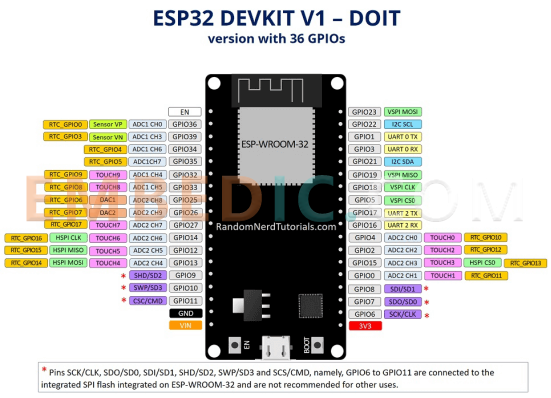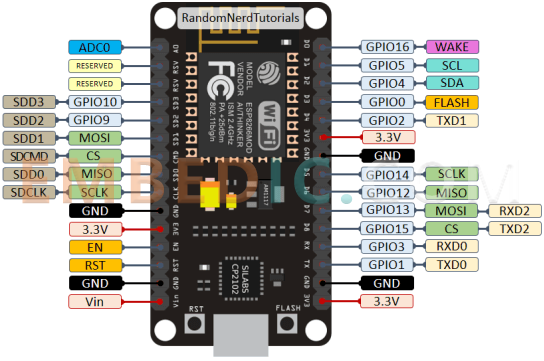What is the difference between the ESP32 and the ESP8266? In this article, we'll compare the ESP32 vs ESP8266 and describe the pros and cons of each board.
The ESP32 and ESP8266 are inexpensive Wi-Fi modules that are perfect for DIY projects in the Internet of Things (IoT) and home automation space.
These modules come with GPIOs that support various protocols such as SPI, I2C, UART, ADC, DAC, and PWM. Best of all, these boards come with a wireless network, which sets them apart from other microcontrollers such as Arduino. This means that you can easily control and monitor devices remotely via Wi-Fi or Bluetooth (in the case of the ESP32) at a very low price.
Or, if you don't need to use its wireless capabilities, you can use the ESP32/ESP8266 to control inputs and outputs, just as you would with an Arduino. However, you should consider that the Arduino operates with 5V logic, while the ESP32 and ESP8266 operate at 3.3V.
The ESP32 is the successor to the ESP8266. It adds an additional CPU core, faster Wi-Fi, more GPIOs, and support for Bluetooth 4.2 and Bluetooth Low Power. In addition, the ESP32 comes with touch sensitive pins that can be used to wake the ESP32 from deep sleep, a built-in Hall effect sensor, and a built-in temperature sensor (the latest version of the ESP32 does not come with a built-in temperature sensor anymore).
Both boards are inexpensive, but the ESP32 is slightly more costly. While the ESP32 costs about 22 to 40 RMB, the ESP8266 costs 12 to 30 RMB (but it really depends on where you get them from and what model you buy).
The following table shows the main differences between the ESP8266 and ESP32 chips (table adapted from AMICA_IO).

Using the ESP32 or ESP8266 bare chips is not easy or practical, especially when it comes to testing and prototyping. Most of the time, you will want to use the ESP32 and ESP8266 development boards. These boards are equipped with all the circuitry needed to power the chip, connect it to a computer, easily upload code, connect pins to peripherals, have built-in power supplies and control LEDs, and other useful functions.
Our more common ESP32 and ESP8266 development boards are the ESP32 DEVKIT DOIT Development Board and the ESP8266 ESP-12E NodeMCU Kit, and these are the ones we recommend for beginners. However, you can choose from many other models of development boards.
The ESP32 has more GPIOs than the ESP8266, and you can decide which pins are UART, I2C, SPI - you need to set this in your code. This is possible because the multiplexing feature of the ESP32 chip allows you to assign multiple functions to the same pin.
If not set in code, the default is on the defined pins, as shown below (using the ESP32 DEVKIT V1 DOIT board (36GPIOS version) as an example) - pin locations can vary by manufacturer).

For comparison, here is the pinout diagram for the ESP8266 ESP-12E NodeMCU development board.

Both chips belong to 32-bit processors. esp32 is a dual-core 160MHz to 240MHz CPU, while esp8266 is a single-core processor running at 80MHz.
Specifications are different. Comparing from specifications, esp32 has faster wifi, more GPIOs and supports Bluetooth 4.2 than esp8266; in addition, ESP32 is equipped with touch sensitive pins for waking ESP32 deep sleep, built-in Hall effect sensor and built-in temperature sensor.
The ESP32 has embedded flash memory of different sizes and supports multiple external QSPI flash and SRAM chips (up to 16MB).
The ESP32 has the same wireless functionality as the ESP8266, but adds a balancing and transceiver switch. Another improvement over the ESP8266EX chip is that the ESP32 embeds an RTC clock, implements TCP/IP and the full 802.11 b/g/n Wi-Fi MAC protocol (four virtual Wi-Fi interfaces) with data rates up to 150mbps, supports legacy Bluetooth protocols and low-power Bluetooth protocols, but in five power management modes will disable these functions.
GPIO pins are different. esp32 chip has 34 GPIO pins, and most GPIOs can be configured with internal pull-up or pull-down resistors, which can be multiplexed with SDIO, UART, etc. esp32 also has two 8-bit DAC channels and a 12-bit SAR ADC, which supports measurement volume from 18 channels. esp32 chip has two 8-bit DAC channels and one 12-bit SAR ADC, which supports measurement volume from 18 channels, in addition to SDIO, SPI, HSPI, I2C, I2S, and UART interfaces, the ESP32 chip also has Hall sensors, 10 capacitive-sensing GPIOs, and an Ethernet MAC interface, in addition to SDIO, HSPI, I2C, I2S, and UART interfaces.
In terms of cost, both are low-cost products, but the cost of ESP32 is slightly higher, and the cost of ESP32 is twice that of ESP8266. Since the ESP8266 has been on the market for a longer time, it can get more support in terms of software and will be easier to use and more compatible. However, the ESP8266 has some limitations in GPIO mapping and does not have enough pins to operate.
In general, ESP32 has advantages in the following aspects.
Summary
It really depends on what you want to do. There are pros and cons to both boards.
The ESP8266 is cheaper than the ESP32. While it is not as versatile, it is suitable for most simple DIY IoT projects. However, it has some limitations in the GPIO mapping, and it may not have enough pins to perform the operations you intend to perform. If this is the case, you should get an ESP32.
The ESP32 is much more powerful than the ESP8266, with more versatile GPIOs, faster Wi-Fi, and support for Bluetooth. However, many people think that the ESP32 is harder to handle than the ESP8266 because it is more complex. On the contrary, in our opinion, programming the ESP32 is as easy as programming the ESP8266, especially if you plan to program it using the "Arduino language" or MicroPython.
ESP32 also has some drawbacks. ESP32 is more expensive than ESP8266. Therefore, if you are building a simple IoT project, the ESP8266 may be able to do so at a lower price. Also, because the ESP8266 is "older" than the ESP32, some libraries and features are better developed for the ESP8266, and you will find more resources (forums, people with the same problems and how to solve them, etc.). However, as time goes on and ESP32 is widely adopted, these differences in development and libraries will not be noticed.
My personal experience: In 2021, I will be using ESP32 almost exclusively for IoT projects. It is more versatile and has more features such as Bluetooth, different wake-up sources, many peripherals, etc. Also, in my opinion, the price difference is not a big deal. Once you move to the ESP32, you don't want to go back to the ESP8266.
Extended Reading:
ESP32 vs STM32, Which is Better and How to Choose 2023
RP2040 vs ESP32: Which Microcontroller is Best for Your Project 2023?
ESP32 vs Arduino: What are Differences and How to Choose
Manufacturer: Analog Devices
IC CCD SIGNAL PROCESSOR 88LFCSP
Product Categories: DSP
Lifecycle:
RoHS:
Manufacturer: Texas Instruments
CI DSP FIXED-POINT 164CFP
Product Categories: DSP
Lifecycle:
RoHS:
Manufacturer: Texas Instruments
IC DGTL MEDIA PROCESSR 1031FCBGA
Product Categories: DSP
Lifecycle:
RoHS:
Manufacturer: Texas Instruments
IC DSP FIX/FLOAT POINT 176HLQFP
Product Categories: DSP
Lifecycle:
RoHS:
Looking forward to your comment
Comment